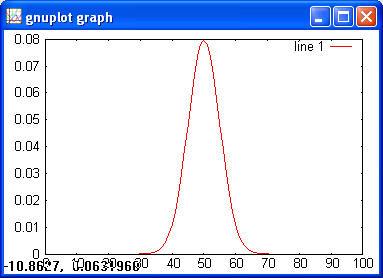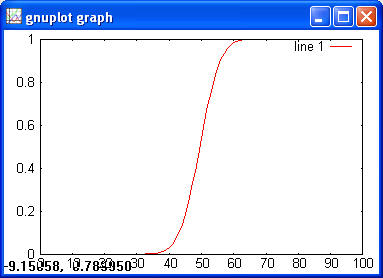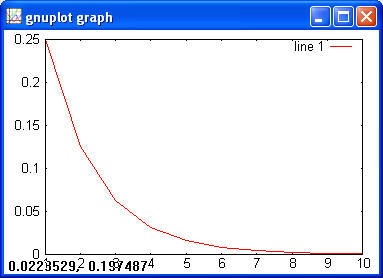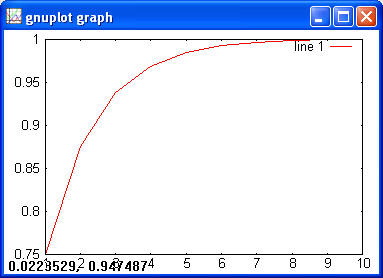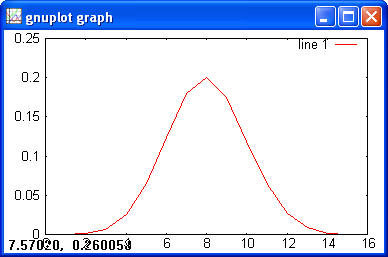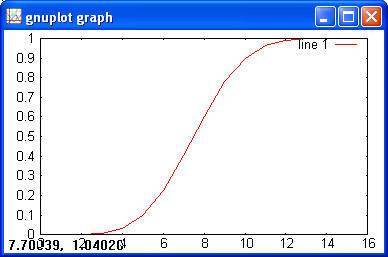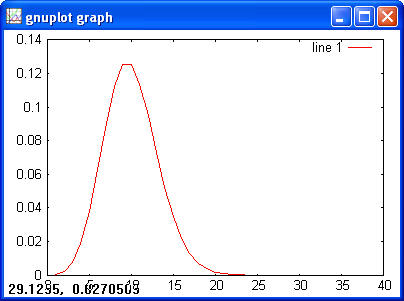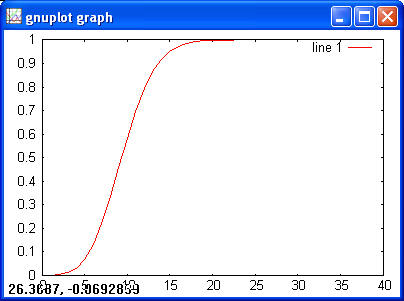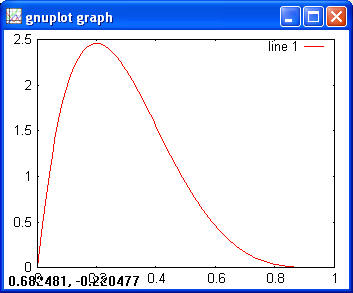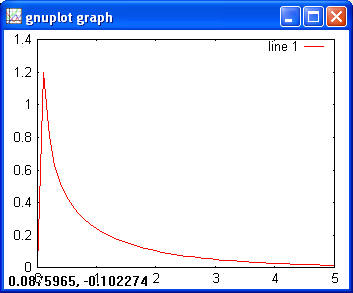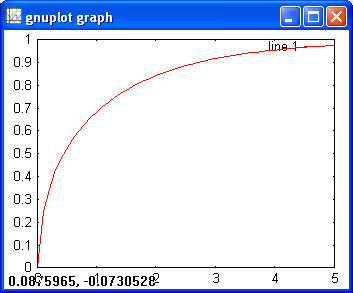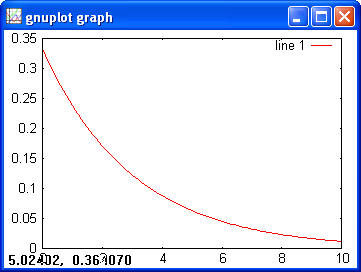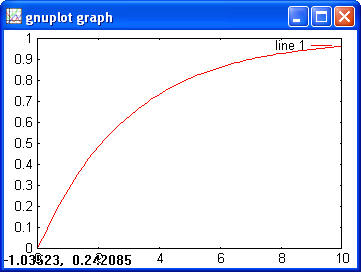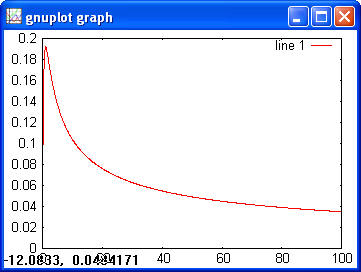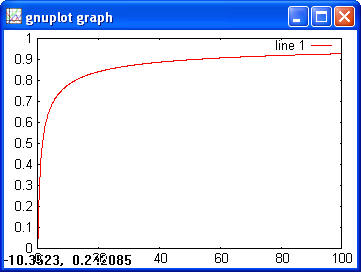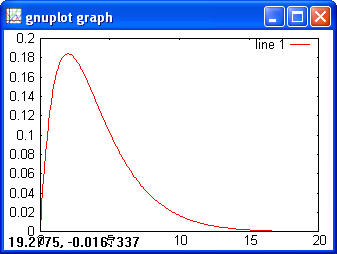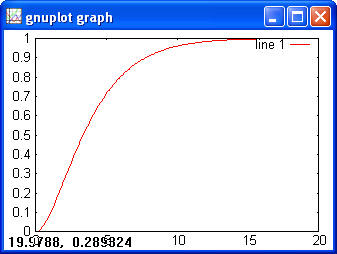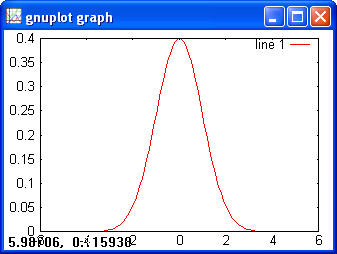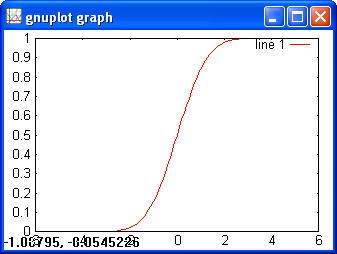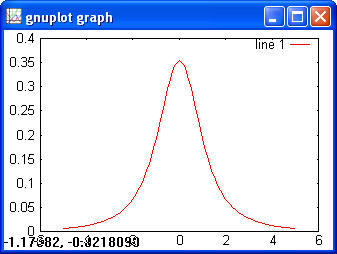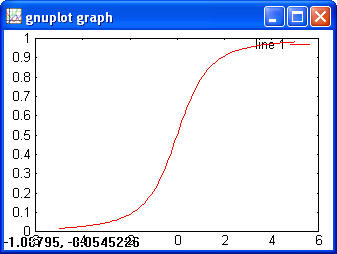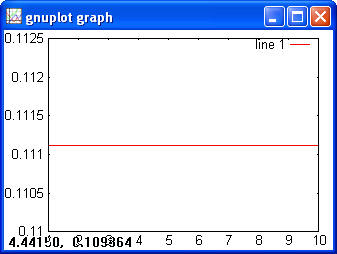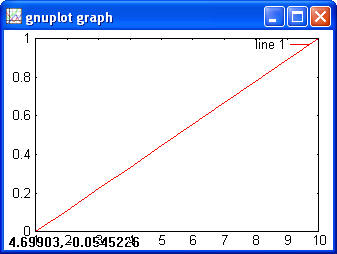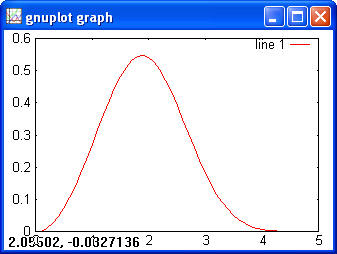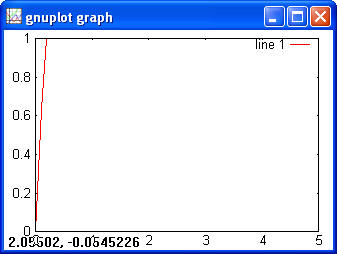|
||||||||||||||||||||||
StatisticsThis chapter introduces the statistics toolbox. This toolbox is based on Jakarta Commons Math project. 9.1 Probability DistributionsThere are two type distributions, continuous and discrete. The statistics toolbox supports following distributions.
This toolbox provides following four functions for each of the distribution.
9.1.1 Discrete DistributionsBinomial> x = 1:100; > y = binopdf(x, 100, 0.5); > plot(x, y)
> y = binocdf(x, 100, 0.5) > plot(x, y)
> x = 0:0.01:0.9; > y = binoinv(x, 100, 0.5) > plot(x, y) > x = 1:5; > y = binocdf(x, 10, 0.5); > binoinv(y, 10, 0.5) > ans = 1 2 3 4 5 > y = binornd(100, 0.5, 1, 10) > y = 51 53 59 43 49 49 52 45 63 47 Geometric> x = 1:10; > y = geopdf(x, 0.5); > plot(x, y);
> y = geocdf(x, 0.5) > plot(x, y)
> y = geocdf(1:10, 0.5) > x = geoinv(y, 0.5) > x = 1 2 3 4 5 6 7 8 9 10 > geornd(0.05, 1, 5) > ans = 2 16 21 0 190 Hypergeometric> x = 0:15; > y = hygepdf(x, 100, 40, 20); > plot(x, y)
> y = hygecdf(x, 100, 40, 20) > plot (x, y)
> x = 1:5; > y = hygecdf(x, 100, 20, 10); > hygeinv(y, 100, 20, 10) > ans = 1 2 3 4 5 > hygernd(100,40,50) > ans = 18 Poisson> x = 1:40; > y = poisspdf(x, 10); > plot(x, y)
> y = poisscdf(x, 10) > plot(x, y)
> x = 1:10; > y = poisscdf(x, 3); > poissinv(y, 3) > ans = 1 2 3 4 5 6 7 8 9 10 > poissrnd(3, 1, 5) > ans = 6 0 3 1 4
9.1.2 Continuous DistributionsBeta> a = 2; > b = 5; > x = 0:0.01:1; > y = betapdf(x, a, b); > plot(x, y)
Other functions are not implemented at this point. Chi-square> x = 0:0.1:5; > y = chi2pdf(x, 1); > plot(x, y)
> y = chi2cdf(x, 1); > plot(x, y)
> chi2cdf(1, 1) > ans = 0.6827 > chi2inv(0.6827, 1) > ans = 1.0000 > chi2rnd(1, [2 3]) > ans = 0.0207 5.2950 2.2307 0.0382 0.2803 0.0084 Exponential> x = 0:0.1:10; > y = exppdf(x, 3); > plot(x, y)
> y = expcdf(x, 3); > plot (x, y)
> x = 1:5; > y = expcdf(x, 2); > expinv(y, 2) > ans = 1 2 3 4 5 F> x = 0:0.1:100; > y = fpdf(x, 2, 1); > plot(x, y)
> y = fcdf(x, 2, 1)
> y = fcdf(1, 1, 10) > ans = 0.6591 >finv(0.6591, 1, 10) > ans = 1.0000
Gamma> x = 0:0.1:20; > y = gampdf(x, 2, 2); > plot(x, y)
> y = gamcdf(x, 2, 2) > plot(x, y)
> gamcdf(1, 2, 2) > ans = 0.0902 > gaminv(0.0902, 2, 2) > ans = 1.0000
Normal> x = -5:0.1:5; > y = normpdf(x); > plot(x, y)
> y = normcdf(x) > plot(x, y)
> normcdf(1) > ans = 0.8413 > norminv(0.8413) > ans = 0.9998 T> x = -5:0.1:5; > y = tpdf(x, 2); > plot(x, y)
> y = tcdf(x, 2); > plot(x, y)
> tcdf(1, 2) > ans = 0.7887 > tinv(0.7887, 2) > ans = 1.0001
Uniform> x = 1:10; > y = unifpdf(x, 1, 10); > plot(x, y)
> y = unifcdf(x, 1, 10); > plot(x, y)
> unifcdf(2, 1, 10) > ans = 0.1111 > unifinv(0.1111, 1, 10) > ans = 1.9999 Weibull> x = 0:0.1:5; > y = weibpdf(x, 0.1, 3); > plot(x, y)
> y = weibcdf(x, 0.1, 3); > plot(x, y)
> weibcdf(1, 1, 3) > ans = 0.6321 > weibinv(0.6321, 1, 3) > ans = 1.0000 9.2 Descriptive StatisticsnumEclipse implements the following few functions for Descriptive statistics. MeanThis method calculates the average value(s) for a matrix. The syntax is as follows
m = mean(X), or m = mean(X, dim) If X is a vector then "mean(X)" returns the mean value of X. In case of a matrix, it will return a row vector containing mean values of a corresponding columns in X. "mean(X, dim)" allows to calculate mean along different dimensions of the matrix. For dim = 1, mean will be calculated along columns of X. For dim = 2, mean will be calculated along rows of X and the mean (X, dim) will return a column vector. Example: > x = [ 8 6 4; 0 4 9; 6 1 9]; > mean(x) ans = 4.6667 3.6667 7.3333 > mean(x, 2) ans = 6 4.3333 5.3333
MedianThis method calculates the median value(s) for a matrix. The syntax is as follows
m = median(X), or m = median(X, dim) If X is a vector then "median(X)" returns the median value of X. In case of a matrix, it will return a row vector containing median values of a corresponding columns in X. "median(X, dim)" allows to calculate median along different dimensions of the matrix. For dim = 1, median will be calculated along columns of X. For dim = 2, median will be calculated along rows of X and the median (X, dim) will return a column vector. Example: > x = [ 8 6 4; 0 4 9; 6 1 9]; > median(x) ans = 6 4 9 > median(x, 2) ans = 6 4 6 VarThis method calculates the variance value(s) for a matrix. The syntax is as follows
m = var(X), or m = var(X, 1) If X is a vector then "var(X)" returns the variance of X. In case of a matrix, it will return a row vector containing variance values of a corresponding columns in X. "var" method normalizes by n-1 where n is the number of data values. Using "var(X, 1)", we can normalize by n. Example: > x = [ 8 6 4; 0 4 9; 6 1 9]; > var(x) ans = 17.3333 6.3333 8.3333 > var(x, 1) ans = 11.5556 4.2222 5.5556
stdThis method calculates the standard deviation value(s) for a matrix. The syntax is as follows
m = std(X), or m = std(X, 1) If X is a vector then "std(X)" returns the standard deviation of X. In case of a matrix, it will return a row vector containing standard deviation values of a corresponding columns in X. "std" method normalizes by n-1 where n is the number of data values. Using "std(X, 1)", we can normalize by n. Example: > x = [ 8 6 4; 0 4 9; 6 1 9]; > std(x) ans = 4.1633 2.5166 2.8868 > std(x, 1) ans = 3.3993 2.0548 2.3570
covThis method calculates the covariance value(s) for a matrix. The syntax is as follows
m = cov(X), or m = cov(X, Y) "cov(X)" calculates the covariance matrix for X, where each column is considered as an observed values of a variable. "cov(X,Y)" calculates the column-wise covariance between X and Y.
Example: > x = [ 8 6 4; 0 4 9; 6 1 9]; > cov(x) ans = -2.0000 -4.0000 -5.6667 -5.0000 -1.0000 2.1667 5.0000 2.5000 -4.1667
9.3 Statistical TestsnumEclipse implements only two methods for statistical tests, i.e., t-test and z-test. These methods are adopted from octave. t-testOctave help provides following text. Function File: [PVAL, T, DF] = ttest (X, M, ALT)
|
||||||||||||||||||||||

